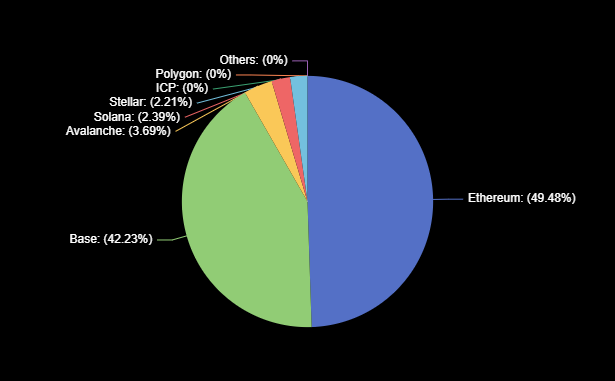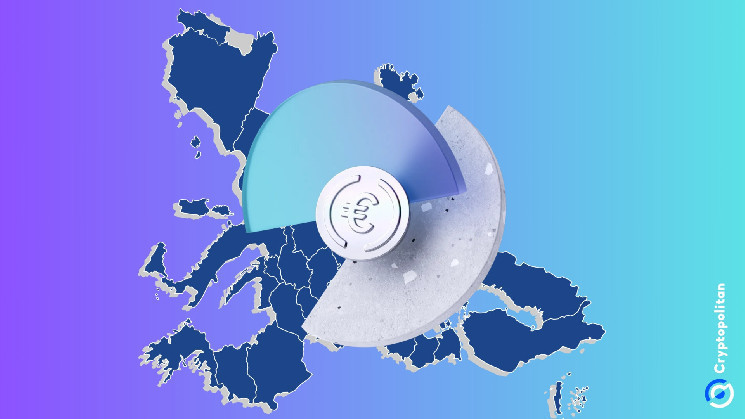The Euro was mostly a forgotten currency in the heavily dollarized stablecoin space. As a less intuitive asset, tokenized Euro lagged behind. Now, EURC by Circle is going for more aggressive expansion, more than doubling its supply since August.
EURC is now the most widely circulated Euro-based stablecoin, after the past two months of supply expansion. EURC is returning to supply levels not seen since 2022, as its supply shrank for years during the bear market. The asset’s supply expanded from $36M market capitalization to above $75M.

EURC has a circulating supply of 67.9M tokens, with most of the growth in the past month happening on the Base chain. EURC also displaced the Celo-based asset, cEUR, which even contracted its supply due to low demand.
The Euro-based asset trades at a slight premium, at 1.12 USDC per coin, compared to the exchange rate of $1.11 per Euro. The asset is already represented on centralized exchanges like Binance and Coinbase.
EURC gets boost from decentralized swaps
Circle launched its EURC asset this July, with the goal of populating Base with another transparent, fiat-backed asset. Circle followed up on its USDC printing on Base, supplying the chain’s emerging DeFi apps.
As of September, EURC is highly active on the Aerodrome Slipstream pair, a high-throughput DeFi trading mechanism that ensures extra liquidity in a predetermined price range. More than 62% of all EURC activity is concentrated on a single Aerodrome DEX pair. Aerodrome is also one of the drivers of growth for both USDC and EURC, as the DEX value locked rose to $1.114B. Both USDC and EURC are minted with decentralized apps in mind, and are compatible with most lending and trading protocols.
EURC trades against USDT and offers another tool to move to and from DeFi protocols. EURC has experimental mints on Polygon and Solana, as well as less widely used chains like Stellar, Avalanche, and Internet Computer (ICP). EURC is fully programmable and bridge-compatible.
Euro stablecoins remained relatively rare in 2024, as Euro area traders could rely on fiat, or on intuitive dollar-based prices. However, EURC looks like a fully legal onboarding tool, especially for Base users. On Coinbase, Euro users can swap EURC without commission. The EURC/USDT pair also aims to serve as a form of on-chain forex trading.
EURC owners are also few, with around 3,500 holders on the Ethereum blockchain. Most of the EURC token supply on Ethereum is held by whales or protocols, with few wallet-to-wallet payments or small-scale holdings. On Base, EURC has around 2,222 holders, though a big part of the supply is locked with protocols like Morpho, or in liquidity pools and passive income vaults.

More than 49% of the EURC supply circulates on Ethereum, with around 42% on Base after highly active minting. EURC still has to catch up with USDC, which has a supply of 3.98B tokens on Base. For USDC, Ethereum is also the more important chain, carrying more than 67% of the minted tokens.
EURC grew in importance after July 2024, and may try to fully replace other types of stablecoins. The asset is fully compatible with the Markets in Crypto-Asset Regulation (MiCA), due to its backing with fiat assets. Circle has also secured an Electronic Money Institution (EMI) license in France, and is testing banks from the Euro Area as reserve-holders.
The Euro-based token is also targeted to businesses, which have access to Circle Mint, a facility to swap EUR into tokens and vice versa. As of September 26, the EURC token reported reserves of $60.9M, in excess of the 60.1M tokens in circulation. In the past month, issues of new EURC were slightly higher than redemptions, for a net growth of 7.3M tokens. USDC expanded its supply in September by 1.9B tokens.
EURC and USDC are partially covered by reserves in banks, and by the Circle Reserve Fund. The fund is also made up of a mix of cash and short-term US Treasury Bills. The presence of fiat reserves and the minting mechanism are sufficient to cover MiCA requirements. As for USDT, its reported backing by US T-Bills is for now insufficient, since Tether has no banking counterparties in the Euro Area.
–
Cryptopolitan reporting by Hristina Vasileva.
 cryptopolitan.com
cryptopolitan.com
